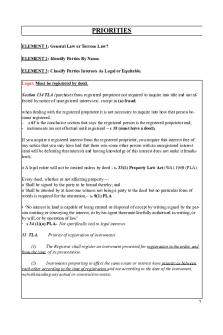Problem Complete Steps PDF

| Title | Problem Complete Steps |
|---|---|
| Author | Muhammad Osama |
| Course | Thermodynamics |
| Institution | National University of Sciences and Technology |
| Pages | 2 |
| File Size | 60.1 KB |
| File Type | |
| Total Downloads | 55 |
| Total Views | 147 |
Summary
nofjfjqeefjerkrjjjjj...
Description
A piston cylinder device, whose piston is resting on a set of stops initially, contains 3 kg of air at 200 kPa and 27oC. The mass of the piston is such that a pressure of 400 kPa is required to move it. Heat is now transferred to the air until its volume doubles. Determine the work done by the air, total heat transferred to the air and entropy generated during the process. Also show the process on a P-v diagram. Solution: Step 1: Problem Statement System: Mass contained within cylinder piston arrangement. It is a closed system. Working fluid: Air Process: expansion; initially at constant volume then at constant pressure Known: mass of air, initial pressure and temperature, final pressure, relation between initial and final volume Find: work transfer, heat transfer, entropy generated Step 2: Schematic Step 3: Assumptions and Approximations i. ii. iii. iv. v. vi. vii.
Leak-proof piston implying the system is closed. Cylinder walls are rigid implying change of boundary is only possible by movement of piston Rigid piston implying no work done in deformation of piston Frictional effects are negligible implying quasi-static process Changes in kinetic, potential, electrical, electromagnetic and other form of energies (except internal energies) are negligible. Air acts as an ideal gas with variable specific heats The system acts only with a thermal source at the temperature equal to final temperature of system
Step 4: Physical Laws Mass balance: not required (closed system) Energy balance: Ein – Eout = ΔEsys For closed system: [ΣQin + ΣWin] - [ΣQout + ΣWout] = ΔE
[Qin + 0] – [0 + Wout] = ΔU + negligible forms Qin – Wout = ΔU Qin – ∫P dV = m (u2 – u1) ………… (eqn 1) Entropy balance: Sin – Sout + Sgen = ΔSsys For closed system: Σ∫(δQin/T)b - Σ∫(δQout/T)b + Sgen = ΔSsys (b in suffix stands for boundary) ∫(δQin/T)source + Sgen = ΔSsys For extended system Qin/Tsource + Sgen = m (s2 – s1) ………… (eqn 2) Step 5: Properties Working fluid: air State 1: P1 = 200 kPa T1 = 27+273 = 300K v1 = RT1 / P1 = (287) (300) / (200 x 103) = 0.4305 m3/kg u1 = 214.07 kJ/kg so1 = 1.70203 kJ/kg K State 2: P2 = 200 kPa v2 = 2v1= 0.861 m3/kg T2 = P2v2 / R = (400 x 103) (0.861) / 287 = 1200 K u2 = 933.3 kJ/kg so2 = 3.17888 kJ/kg K Step 6: Calculations Wout = ∫P dV = ∫isochoricP dV + ∫isobaricP dV = 0 + P2 m (v2 – v1) = (3) (400x103) (0.861 – 0.4305) = 516.6 k J From eqn 1 Qin = m (u2 – u1) + Wout = 3 (933.3 – 214.07) + 515.6 = 2674.29 kJ From eqn 2 Sgen = m (s2 – s1) + Qin / Tsource = m [ (so2 – so1) – R ln(P2/P1)] + Qin / T2 (assumption vi & vii used) =3 [(3.1788 – 1.70203) – 287 ln(400x103/200x103)] – 2674.29/1200 = 1.6049 kJ/kg K...
Similar Free PDFs

Problem Complete Steps
- 2 Pages

PF Steps-1 - practice steps
- 10 Pages

Steps OF
- 14 Pages

Steps in online transaction
- 1 Pages

Steps in Quantitative Analysis
- 7 Pages

The steps the process
- 3 Pages

FUNDAMENTAL DANCE STEPS
- 14 Pages

Seven Steps To Subnetting
- 4 Pages

2.2 generate steps
- 2 Pages

Metabolism - Key Steps
- 5 Pages

KDD process steps
- 6 Pages

Priorities Property law steps
- 12 Pages

The thirty-nine steps
- 6 Pages

1 First Steps to success
- 10 Pages
Popular Institutions
- Tinajero National High School - Annex
- Politeknik Caltex Riau
- Yokohama City University
- SGT University
- University of Al-Qadisiyah
- Divine Word College of Vigan
- Techniek College Rotterdam
- Universidade de Santiago
- Universiti Teknologi MARA Cawangan Johor Kampus Pasir Gudang
- Poltekkes Kemenkes Yogyakarta
- Baguio City National High School
- Colegio san marcos
- preparatoria uno
- Centro de Bachillerato Tecnológico Industrial y de Servicios No. 107
- Dalian Maritime University
- Quang Trung Secondary School
- Colegio Tecnológico en Informática
- Corporación Regional de Educación Superior
- Grupo CEDVA
- Dar Al Uloom University
- Centro de Estudios Preuniversitarios de la Universidad Nacional de Ingeniería
- 上智大学
- Aakash International School, Nuna Majara
- San Felipe Neri Catholic School
- Kang Chiao International School - New Taipei City
- Misamis Occidental National High School
- Institución Educativa Escuela Normal Juan Ladrilleros
- Kolehiyo ng Pantukan
- Batanes State College
- Instituto Continental
- Sekolah Menengah Kejuruan Kesehatan Kaltara (Tarakan)
- Colegio de La Inmaculada Concepcion - Cebu

